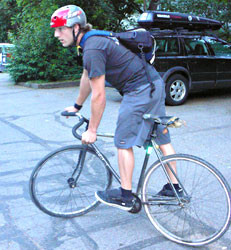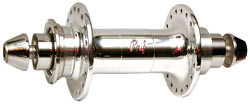Fixie bikes, with their sleek lines and minimalist design, aren’t just a mode of transport; they’re a statement. In urban landscapes around the globe, you’ll spot riders effortlessly weaving through traffic on these unique machines. But what exactly is a “fixie,” and why are they gaining so much traction? Short for “fixed gear,” these bikes offer a pure, unfiltered cycling experience, connecting rider and road in a way few others can. If you’re intrigued by the simplicity, the style, and the sheer fun of fixie riding, you’ve come to the right place. This guide will dive deep into the world of fixed gear bikes, helping you understand what makes them special and how to find the best fixie bike for your needs and adventures.
Understanding the Fixie Feeling: Simplicity and Connection
At its heart, a fixie bike is defined by its drivetrain. Unlike conventional bicycles with gears and freewheels, a fixie has a single gear directly connected to the rear wheel. This means when the wheels turn, the pedals turn – and vice versa. There’s no coasting; you are in constant motion, intimately linked to the rhythm of the bike. This direct connection is what many fixie enthusiasts find so compelling. It harkens back to the earliest days of cycling, stripping away complexity and leaving only the essential elements of bike and rider.
 Stylish fixie bike rider performing a track stand in an urban environment, showcasing the balance and control possible on a fixed gear bicycle.
Stylish fixie bike rider performing a track stand in an urban environment, showcasing the balance and control possible on a fixed gear bicycle.
This inherent simplicity translates into several key advantages that make fixie bikes stand out:
- Low Maintenance: With fewer components like derailleurs, shifters, and complex gearing systems, fixies require significantly less maintenance than geared bikes. This makes them incredibly reliable and perfect for daily commuting or urban exploration where you need a dependable ride.
- Efficient Pedaling: The fixed gear system eliminates the “dead spot” in your pedal stroke, leading to a smoother, more efficient transfer of power. You become more aware of your pedaling technique, naturally improving your efficiency and cadence over time. Learning to spin efficiently becomes second nature when you’re constantly pedaling.
- Enhanced Bike Control and Handling: The direct drive provides an unparalleled sense of control. You can subtly modulate your speed and even brake by resisting the pedal rotation, offering a unique level of bike handling, especially in urban environments.
- A Unique and Engaging Ride: Riding a fixie is simply different. It demands your attention, engages your body in a new way, and offers a pure, unadulterated cycling experience. It’s a fun and challenging way to rediscover the joy of riding.
- Style and Personalization: Fixies have become synonymous with a distinct urban style. Riders often express their individuality through customization, from vibrant paint jobs to unique components and accessories, making each fixie a personal statement.
Track vs. Road Fixies: Choosing the Right Type for You
The term “fixie” often brings to mind images of track bikes racing around velodromes. While track bikes are indeed fixed gear, they are specifically designed for the unique demands of track cycling and aren’t always the best choice for everyday street riding.
Track bikes are built for speed and efficiency on smooth, banked tracks. They are characterized by:
- No Brakes: Track bikes are typically brakeless as they are ridden in controlled track environments where braking is unnecessary and even discouraged for safety reasons.
- Stiff Frames: Track bikes feature incredibly stiff frames for maximum power transfer and responsiveness during high-speed racing.
- Aggressive Geometry: Their geometry is optimized for tight handling and aggressive riding positions, essential for track racing.
While some experienced fixie riders, particularly those with a track cycling background, may choose to ride track bikes on the street, they are generally not ideal for most urban riders. The stiff ride can be unforgiving on rough city streets, and the ultra-responsive handling requires constant attention.
For everyday fixie riding, road-oriented fixies are a far better choice. These bikes are designed with street usability in mind and typically feature:
- Brakes: Essential for safe street riding, road fixies come equipped with front and rear brakes.
- More Comfortable Geometry: Road fixie frames offer slightly more relaxed geometry for better comfort and stability on varied road surfaces.
- Versatility: Many road fixies can also be converted to single-speed freewheel bikes, offering the option to coast if desired.
When looking for the best fixie bike for urban riding, prioritize models designed for the street. They will provide a more comfortable, safer, and enjoyable experience compared to track-specific machines.
Gearing Up: Selecting the Best Gear Ratio for Your Fixie
With only one gear to choose from, selecting the right gear ratio for your fixie is crucial. The “best” gear ratio is subjective and depends on several factors:
- Your Riding Style (Cadence): Do you prefer to pedal at a high cadence (spinning quickly) or a lower cadence (pedaling with more force)?
- Your Typical Terrain: Will you be riding mostly on flat roads, or will you encounter hills and inclines?
- Your Fitness Level: Stronger riders can handle higher (harder) gear ratios, while less experienced riders may prefer easier gears.
Here are some general guidelines for choosing a fixie gear ratio:
- For Flat Urban Riding: A gear ratio around 2.7 to 3.0 is a good starting point for general urban commuting and flat terrain. This provides a balance of speed and ease of pedaling.
- For Hilly Terrain: If you live in a hilly area, you’ll need a lower (easier) gear ratio, perhaps around 2.5 to 2.7. This will make climbing hills more manageable.
- For Experienced/Strong Riders: More experienced and stronger riders might opt for higher gear ratios (3.0 and above) for faster riding on flat terrain and a more challenging workout.
A helpful tip for fixies is that the efficiency of the fixed gear system often allows you to handle a slightly higher gear ratio than you might be accustomed to on a geared bike. The momentum of the fixed wheel helps carry you through.
When purchasing a new fixie, reputable bike shops can provide expert guidance in selecting the perfect gear ratio for your individual needs and riding style. Don’t hesitate to test ride different gear ratios to find what feels most comfortable and efficient for you.
Essential Fixie Components: Hubs, Chains, and Frames
While fixies are simple, certain components play a critical role in their performance and durability.
The Heart of the Fixie: The Rear Hub
The rear hub is arguably the most specialized component on a fixie. Unlike standard hubs, fixie hubs are designed to accommodate the fixed cog and lockring system. Key features of a fixie rear hub include:
- Double-Sided Threads: The right side of the hub features two sets of threads – one for the fixed cog and an outer, reverse-threaded set for the lockring.
- Lockring: The lockring threads against the cog in the opposite direction, preventing the cog from loosening due to backpedaling forces.
 Close-up of a high-quality Phil Wood fixed gear hub, emphasizing the importance of components in best fixie bikes and showcasing bicycle jewelry.
Close-up of a high-quality Phil Wood fixed gear hub, emphasizing the importance of components in best fixie bikes and showcasing bicycle jewelry.
For ultimate durability and performance, consider high-quality fixie hubs from reputable brands like Phil Wood. These hubs are often considered “bicycle jewelry” for their precision engineering and longevity.
Chains: 1/8″ vs. 3/32″
Fixie chains come in two main widths: 1/8 inch and 3/32 inch.
- 1/8″ Chains: These wider, heavier chains are commonly found on track bikes, BMX bikes, and older, robust bicycles. They are known for their strength and durability.
- 3/32″ Chains: Narrower and lighter, 3/32″ chains are the standard for multi-speed road and mountain bikes. They offer more flexibility and smoother, quieter pedaling, making them a popular choice for road fixies. If you are converting a vintage road bike to a fixie, using a 3/32″ chain allows you to reuse the original crankset.
Frames: Finding the Right Foundation
The frame provides the foundation for your fixie. While you can convert many frames to fixed gear use, those with horizontal dropouts are essential. Horizontal dropouts allow you to adjust the rear wheel position to tension the chain properly – a crucial aspect of fixie setup.
Older steel road bike frames, particularly those from the 1980s and 90s, are excellent candidates for fixie conversions. These frames often feature:
- Horizontal Dropouts: A key requirement for fixie conversions.
- Quality Steel Tubing: Offering a comfortable and durable ride.
- Classic Aesthetics: Often featuring attractive lugs and timeless styling.
Before starting a fixie project, check your garage or local used bike shops for a vintage steel road frame – it might be the perfect starting point for your custom fixie build.
Making it Your Own: Customizing Your Fixie
One of the most appealing aspects of fixie culture is the emphasis on personalization and style. Fixie riders often take pride in making their bikes unique expressions of themselves. Customization options are virtually limitless:
- Handlebars and Grips: From classic drop bars to urban-style flat bars with colorful grips, your handlebar setup dramatically impacts the look and feel of your fixie.
- Wheels and Rims: Deep-dish rims, color-matched hubs, and even disc wheels can add a bold visual statement.
- Vintage Components: Embrace retro style with vintage components like cottered cranks, leather saddles, and quill stems.
- Paint Jobs: A custom paint job is the ultimate way to make your fixie truly one-of-a-kind.
Don’t be afraid to get creative and let your personality shine through in your fixie build. It’s about creating a bike that not only rides well but also reflects your individual style.
Ready to Ride the Best Fixie Bike for You?
Fixie bikes offer a unique and rewarding cycling experience. Their simplicity, efficiency, and inherent style have captivated riders worldwide. Whether you’re seeking a low-maintenance commuter, a fun urban explorer, or a blank canvas for personal expression, a fixie bike might be the perfect choice for you.
We invite you to explore our wide selection of fixie and single-speed bikes and discover the perfect ride to match your style and needs. Our experts are here to answer your questions, offer advice, and help you with all your fixie projects. Come visit us and experience the fixie feeling for yourself!

